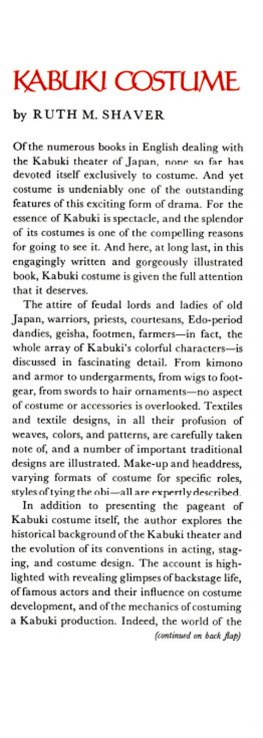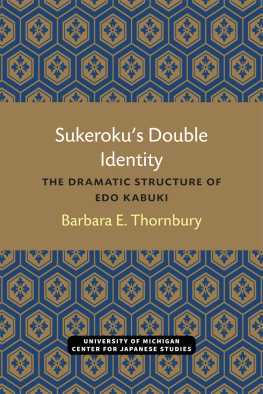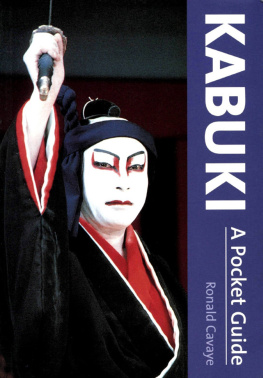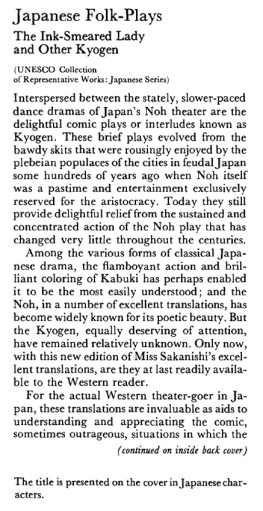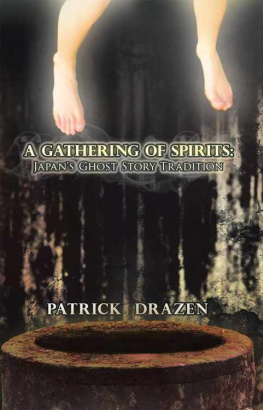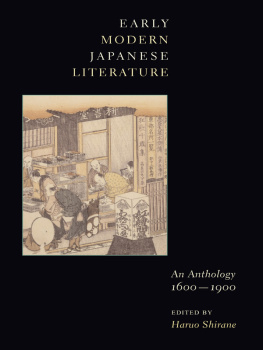APPENDIX
Three Translations of
Kabuki Plays
by
Faubion Bowers
The Monstrous Spider ( Tsuchigumo)
A dance-drama adapted from the Noh, and included in the Onoe Family's collection of plays, "Ten Favorite Plays, New and Old."
Gappo and His Daughter Tsuji ( Sesshu Gappo ga Tsuji)
Adapted from a Bunraku Puppet Theatre domestic play.
Sukeroku ( Sukeroku Yukari Edo Zakura)
An original Edo Kabuki play in aragoto style, and included in the Ichikawa Family's collection of "Eighteen Favorites."
Notes on the Translations
The charm of Kabuki is essentially in its atmosphere. The language is beautiful in Japanese and is filled with poetic allusions and plays on words which are impossible to translate. The word is actually an excuse for music, and music in turn is an excuse for acting or dance-like movement. In this way the text is seen to be only a third part of Kabuki. In translation, unfortunately, it becomes even less significant. However, some of the mood, it is hoped, shines through.
The titles of Kabuki are selected for the beauty of the ideographs, and are uneven in number. They are usually meaningless, and are designed to express the atmosphere of the drama. Plays are rarely spoken of by their original tides which are too difficult even for the actors to remember. They are referred to, for convenience' sake, by the names of the leading characters or the main scene.
THE MONSTROUS SPIDER
(Tsuchigumo)
Notes:
In ancient Japan it was believed that a race known as tsuchigumo (ground spiders), had formerly inhabited the land. Etymologically the word comes from tsuchi gomori (living in caves). Since legendary time a tale called Tsurugi no maki was widely popular and is considered the prototype of all subsequent spider stories in Japanese literature. Tsurugi no maki is substantially the same as the present version of The Monstrous Spider , except that Raiko's sword is named Hizamaru which after successfully killing a spider "four feet high and living in a huge mound," is renamed Kumo kiri maru. Raiko is the stage name of the actual historical man known as Minamoto Yorimitsu who lived from 994 to 1021 A.D.
The story appears in Noh under the title Tsuchigumo ; in joruri storytelling as Tsuchigumo Taiji, written by Inoue Harima-no-jo; in a puppet play as Kanhasshu Tsunagi Uma, written by Chikamatsu Monzaemon in 1724. In the puppet version, the spider is treated as a demoniac form of a Taira maiden named Kocho. The only Kabuki version known today is the present adaptation from Noh.
In 1881, Onoe Kikugoro V was pressed for a new play in order to commemorate the thirty-third anniversary of the death of Onoe Baiju (Kikugoro III). A patron suggested that since Kikugoro V's grandfather, Onoe Shoroku I, had played a form of Tsuchigumo in 1804, and also the late Baiju had played a role of a ghost spider in 1845, both with great success, a play on a similar theme would be appropriate. Kawatake Mokuami's help was enlisted. The selection of Tsuchigumo from the Noh was partly an effort to find a match for The Subscription List (Kanjincho ), an early Noh adaptation and already long a success with the rival Ichikawa family. Subsequently the government had reinvoked the traditional law forbidding Kabuki players from borrowing from Noh. After considerable pressure from a high official, a patron of Noh and of Kikugoro V, the author and actor, were finally allowed to introduce the text into Kabuki. Critics assailed it as impure, since it was seven parts Noh and three parts Kabuki. But after repeated performances, it was successful and became one of the "10 Favorite Plays, Old and New, of the Onoe Family" ( Shin Ko Engeki Ju Shu). The Monstrous Spider was the first adaptation from the Noh during the Meiji Era, and started the spate of adaptations which followed.
In Noh as well as in their adaptations in Kabuki, "demon plays" of which The Monstrous Spider is typical, follow a characteristic form: a) the demon in disguise (winning over his opponent); b) a comic interlude (performed by extraneous characters); c) the demon in his true colors (vanquished by his opponent).
The dance-drama is performed to the accompaniment of Naga uta (long song) music. The setting is a painted background showing a single pine tree, characteristic of Noh plays, and at the side, stalks of bamboo.
Synopsis
The Monstrous Spider is the story of Raiko who is suffering from a mysterious ailment. He has asked the prelates of various Buddhist temples to pray for his recovery. At midnight the "Monstrous Spider" assumes the disguise of a priest and tries to kill him by his sorcery. Raiko cuts him with his sword, and by following the blood tracks his retainers, the four loyal paladins are able to pursue the spider to his lair. The spider is killed and Raiko recovers from his ailment.
Characters
The priest Chichu (in reality the Monstrous Spider)
Raiko
Yasumasa (Raiko's attendant)
Watanabe no Tsuna (Raiko's retainer)
Sakata no Kintoki (Raiko's retainer)
Urabe no Suetake (Raiko's retainer)
Usui no Sadamitsu (Raiko's Retainer)
Kocho (a lady attendant)
(Yasumasa enters)
Yasumasa: I am Hirai Yasumasa, an attendant of Lord Raiko, and the bravest warrior of the Minamoto clan. My lord, having been sick in bed for some time, had the apothecary prepare medicines for him. As they had no effect on him, he asked the prelates of various temples to hold Buddhist services for his recovery. To my great joy, I hear that he is better, and I have come to inquire after his condition.
(Seats himself)
Music:
"Drifting, drifting with the wind,
Clouds float in the sky.
There appears Lord Raiko
Long suffering from his illness,
Wishing to breathe the freshness of the evening air."
(Raiko enters)
Yasumasa: How do you feel, my lord?
Raiko: The apothecary has done well and, thanks to his ministrations, I am much improved of late. Look at the chrysanthemums here in the garden.
Yasumasa: Chrysanthemums are flowers of good fortune. It is said that their fragrance has the virtue of prolonging life. I hope you will completely recover before long, my lord.
Raiko: At the end of August, I went to Ichijo-
Music:
"When the long autumn night
Turned to dawn at last,
We, the lady and I,
Parted from each other
With much regret.
And as I came back in the cool breeze-"
Raiko: I felt cold and then fell ill.
Yasumasa: Your attendants did all they could.
Music:
"His Majesty the Emperor
Deigned to send the head apothecary
To prepare medicines for him."
Yasumasa: And I hear, much to my joy, that you are better.
Raiko: Go and rest yourself.
Yasumasa: Thank you, my lord.
Music:
"Thus saying,
Yasumasa retires to the anteroom."
(Yasumasa leaves)
"As the moon begins
To hide behind the clouds,
Quietly and gracefully.
Kocho, the lady attendant,
Approaches Lord Raiko."
(Kocho enters)
Kocho: Is anyone here?
Page: Who is there?
Kocho: I, Kocho, a woman in attendance.
Page: My lord has been long waiting for you. Come in, please.
Kocho: Thank you.
(Kneels before Raiko)
I have brought you medicine from the apothecary. How do you my lord?
Raiko: Much better these few days. I will soon be restored.
Kocho: I am most glad to hear it, my lord.
Raiko: The hills must be aflame with autumnal tints now.
Kocho: Oh, they are like burning fire.
Raiko: Come and describe them to divert my mind.
Kocho: With pleasure, my lord.
(She begins to dance)
Music:
"Takao mountain is famous for its maple trees
With their autumnal tints.
The summit of Ogura mountain is lit
With the splendour of the setting sun.


